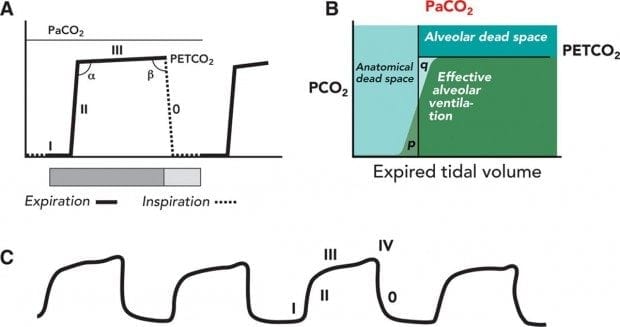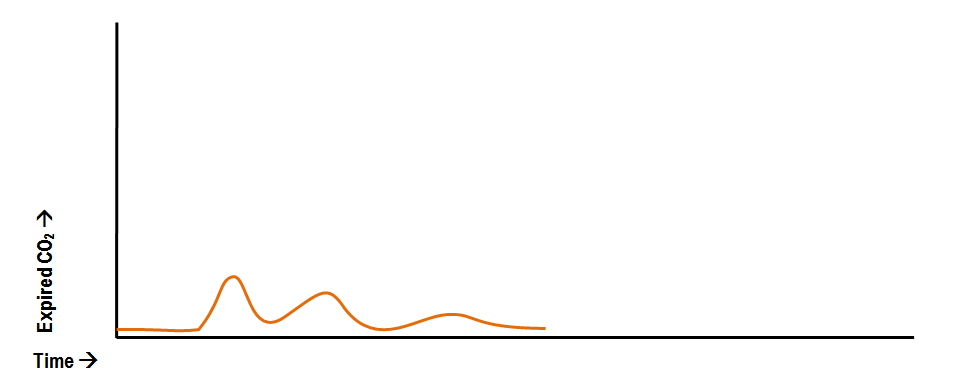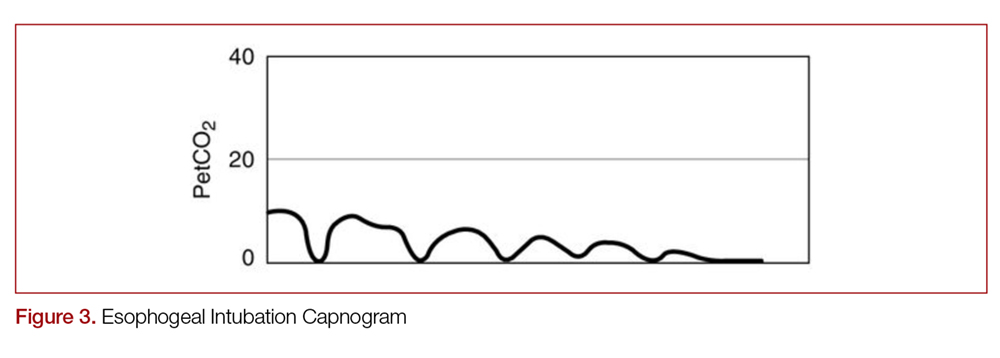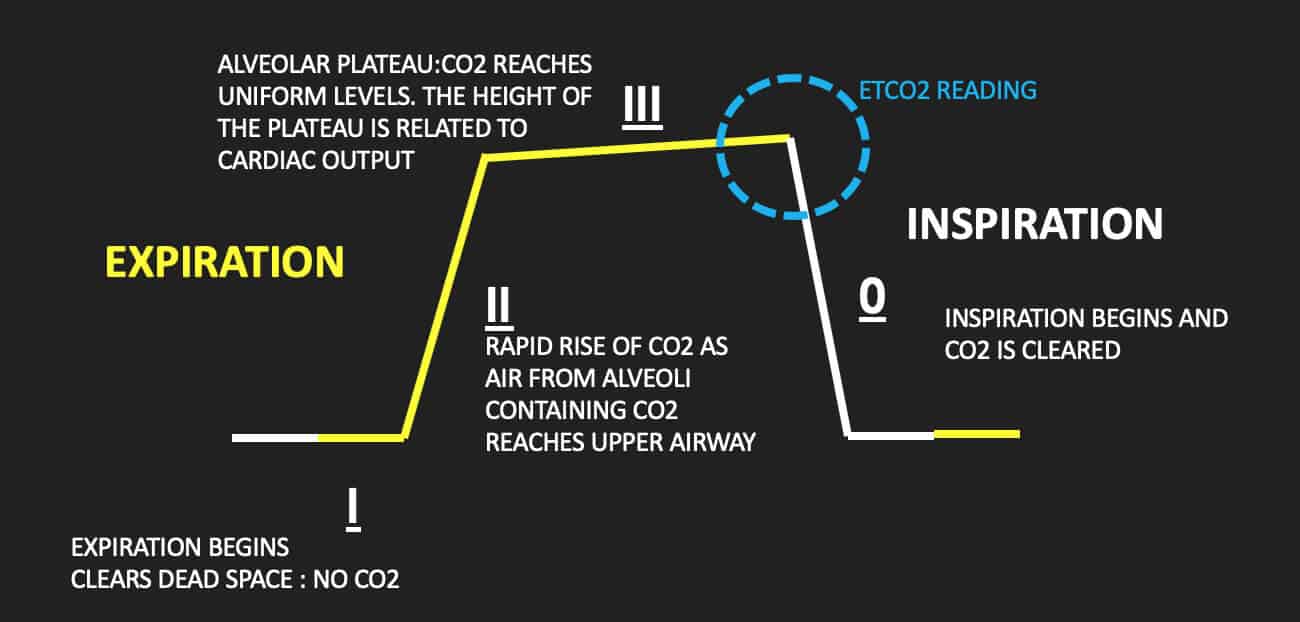normal end tidal co2 after intubation
The normal values are 5-6 CO2 which is equivalent to 35-45 mmHg. Waveform capnography represents the amount of carbon dioxide CO 2 in exhaled air which assesses ventilation.

Waveform Capnography In The Intubated Patient Emcrit Project
The use of quantitative end-tidal capnometry to avoid inadvertent severe hyperventilation in patients with head injury after paramedic rapid sequence intubation.

. It consists of a number and a graph. Silvestri S Ralls GA Krauss B Thundiyil J Rothrock SG Senn A et al. For two cadavers life-like ETCO 2 waveforms were achieved immediately after tracheal intubation with maximum ETCO 2 achieved by the second breath.
The waveform is called capnograph and shows how much CO 2 is present at each phase of the respiratory cycle. N Engl J Med. The number is called capnometry which is the partial pressure of CO 2 detected at the end of exhalation ranging between 35 - 45 mm Hg or 40 57 kPa.
In these cases waveform morphology was normal and continued to the 2 min cessation point. Immediately after intubation etCO2 can help adjust the ventilator settings. Measurement of end-tidal carbon dioxide ETCO2 has been used to detect accidental esophageal tube placement in noncardiac arrest situations.
4 etCO2 target can be achieved with a relatively normal minute ventilation. Changes in the shape of the capnogram are diagnostic of disease conditions while changes in end-tidal CO 2 EtCO 2 the maximum CO 2 concentration at the end of each tidal breath can be used to assess disease severity and response to treatment. The presence of a normal waveform denotes a patent airway and spontaneous breathing.
Silvestri S Ralls GA Krauss B et al. End-tidal CO 2 changes during the experiment showed a resting value of 45 mm Hg decreasing to 34 mm Hg at 5 minutes 27 mm Hg at 10 minutes and increasing to 40 mm Hg at 15 minutes all p. Capnography is the most reliable indicator that an endotracheal tube is placed in the trachea after intubation.
Authors A J Sayah 1 W F Peacock D. The amount of CO2 at the end of exhalation or end-tidal CO2 ETCO2 is normally 35-45 mm HG. End tidal CO 2 monitoring is represented as a number and a graph on a monitor.
428 153 mmHg versus 323 141 mmHg. Misting increased SaO2 Types of End-Tidal CO2 Qualitative Yes or No. End tidal normally 2-5 mmHg lower than arterial Comparing Arterial and End-tidal CO2 Review of Airway Confirmation Visualization Auscultation.
Rapid Sequence Intubation Figure 1-3 End-tidal CO2 detector before application. Oxygen and ventilation are distinct physiologic functions that must be assessed in both intubated and spontaneously breathing patients. End-tidal carbon dioxide is better than arterial pressure for predicting volume responsiveness by the passive leg raising test.
On inspection of the sodalime canister we observed that the sodalime was filled till the. End-tidal CO2 measurement in the detection of esophageal intubation during cardiac arrest Ann Emerg Med. Main outcome measures The time following intubation for ETCO 2 levels to be initially detected and to reach 4 mm Hg and 15 mm Hg.
Was normal however after induction and intubation an increasing trend of the inspiratory carbon dioxide was noticed. 2 to near normal normal EtCO 2 35-45 mmHg represents marked increase of CO 2 delivery to lungs suggesting ROSC If patient develops an organized rhythm after VFVTasystole check EtCO 2 to see if ROSC has occurred CONFIRM PLACEMENT OF ETT After intubation if ETCO 2 10mm Hg tube in trachea. Videos of the waveforms are available as online supplementary files numbers 18.
In mmHg the PetCO2 values for those with and without ROSC after five minutes of CPR was. 423 20 mmHg versus 34 255 mmHg. A prospective clinical trial was conducted at a level I trauma center to assess the efficacy of end-tidal carbon dioxide CO2 detection in four groups of patients requiring emergency intubation because of cardiac arrest major trauma respiratory failure or the need for airway protection.
During the period of relative hypoventilation the oxygen gradient increased to 62 mm Hg p. ETCO2 emergency department monitoring and critical. This was followed by an increase in end tidal carbon dioxide after a few minutes.
The indicator is purple which indicates failure to detect CO2. Intensive Care Med. A semiquantitative colorimetric FEF end-tidal CO2 detector Fenem Inc.
End-tidal capnography or end-tidal CO2 EtCO2 monitoring is a non-invasive technique that measures the partial pressure or maximal concentration of carbon dioxide CO2 at the end of an exhaled breath. Bataille A Magalhaes E et al. This is end-tidal CO 2 ETCO 2 which is normally 35 to 45 mm Hg in dogs and 28 to 32 mm Hg in cats.
End-tidal carbon dioxide and outcome of out-of-hospital cardiac arrest. Results The median time for initial detection of ETCO 2 following intubation was 37 range 044 s which was significantly shorter than the median time for ETCO 2 to reach 4 mm Hg 53 range 0727 s and to reach 15 mm Hg 81 range 0827. Can the value of end tidal CO2 prognosticate ROSC in patients coding into emergency department with an out-of-hospital cardiac arrest.
Return of spontaneous circulation. A high peak of the alveolar phase in poorly compliant lungs. A semiquantitative colorimetric FEF end-tidal CO2 detector Fenem Inc New York NY was used to evaluate endotracheal versus esophageal intubation.
The effectiveness of out-of-hospital use of continuous end-tidal carbon dioxide monitoring on the rate of unrecognized misplaced intubation within a regional emergency medical services system. End-tidal CO2 diminishes over time Sudden increase in ETCO2. In this study the aim was to review the applications of end-tidal carbon dioxide ETCO2 monitoring in emergency department multiple databases were comprehensively searched with combination of following keywords.
Capnograph is an indispensable tool for monitoring metabolic and respiratory function. The effectiveness of out-of-hospital use of continuous end-tidal carbon dioxide monitoring on the rate of unrecognized misplaced intubation within a regional emergency medical services system. Capnography can be used to assess unresponsive patients ranging from those are actively seizing to victims of chemical terrorism.
The number represents capnometry which is the partial pressure of CO 2 detected at the end of exhalation. This is t he appearance when the. Graphically this difference in ROSC vs non-ROSC PetCO2 for both groups appeared to be even greater at ten minutes.
When CO2 diffuses out of the lungs into the exhaled air a device called a capnometer. Negative Epigastric sounds Equal lung sounds Esophageal detector End tidal CO2 detector Secondary signs. Capnography is also the most reliable indicator that an endotracheal tube is placed in the trachea after intubation.
The box on the lower right-hand side of the graph depicts time to recovery from succinylcholine which in almost all cases exceeds safe apnea time. Waveform and end -tidal carbon dioxide EtCO2 values. Norm al EtCO2 levels 46 to 60 kPa signify adequate perfusion.

Capnography Waveform Interpretation Litfl Ccc Equipment

Capnography Nursing Procedures Icu Nursing Nursing School Studying

End Tidal Co2 Respiratory Therapy Tidal Co2

Waveform Capnography In The Intubated Patient Emcrit Project

Abnormal Capnography Waveforms And Their Interpretation Deranged Physiology

Basic Capnography Interpretation Nuem Blog

Waveform Capnography In The Intubated Patient Emcrit Project

3 Waveform Capnography Showing Changes In The End Tidal Carbon Dioxide Download Scientific Diagram

Potential Applications Of Capnography In The Prehospital Setting Journal Of Paramedic Practice

Waveform Capnography In The Intubated Patient Emcrit Project

Waveform Capnography In The Intubated Patient Emcrit Project

How To Read And Interpret Capnography Waveforms Infinium Medical
End Tidal Co2 Monitoring In The Pre Hospital Environment More Than Just Endotracheal Tube Placement Confirmation Journal Of Paramedic Practice

Waveform Capnography In The Intubated Patient Emcrit Project

The Impact Of Ventilation Rate On End Tidal Carbon Dioxide Level During Manual Cardiopulmonary Resuscitation Resuscitation

End Tidal Capnography In The Emergency Department Mdedge Emergency Medicine


